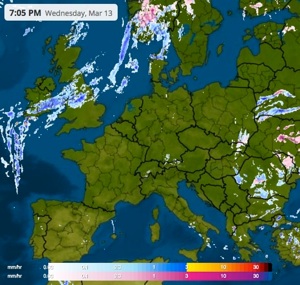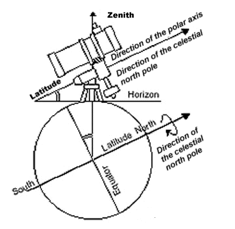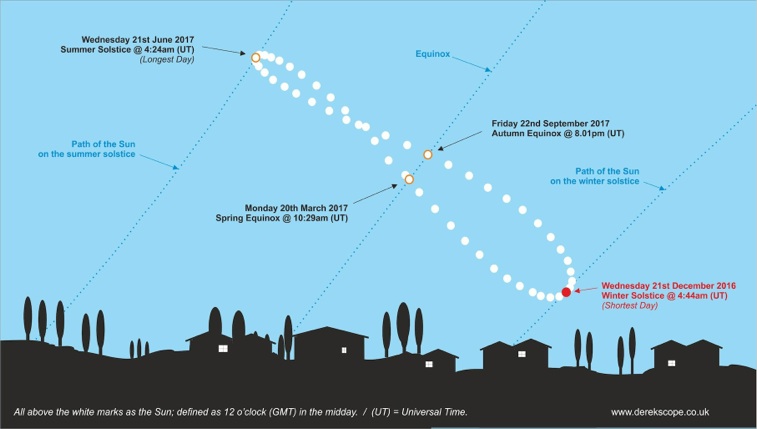Astronomy

Night Sky Observer
Sadly the best site l know closed in Spring 2017. It had very full clear explanations. In case it comes back I’ll leave this link.
General Advice
Weather Forecasting
West Of London Astronomical Society
Formed in 1967 it is my local branch of the British Astronomical Association (formed 1890 it too has a massive website). WOLAS now has 170 members and is the largest society in the South-East of England. They meet monthly with guest expert in Harrow or Uxbridge. Very friendly. This is an extensive website. Don’t miss their links page. (Jan 2010)
BBC News basic current 24h or less. Shows UK only.
European Free Maps
Weather Online a reasonably good site which has plenty of current and forecast maps for temps, precipitation, cloud cover, expert maps, history webcams, water conditions etc
The Weather Channel gives an overall view. Forecasts are simply depicted.
Derekscope
I like Derek Rowley’s site for topical observing in UK. He has some splendid explanations. For example the diagram to the right explains the precession of the midday sun across the UK night sky through the seasons. (Dec 2017)
Night Sky Apps - A Warning
There are a huge number of apps for all platforms to so called ‘help’ you view the night sky. There are far more reviews than apps even ! Both groups are profit making and will deluge you with ads and cookies so I suggest that you make sure that your Firewall and other protections are fully clamped down before launching into a universe of appalling spam.
Three years ago I put one on my Nexus tablet, which has GPS, and it still works wonderfully well. However I’d be very very careful when downloading now.
(Summer 2017)
Photography - Photo Stacking
Getting good pictures is a skilled business because not only does one need a very sensitive camera but it will need to be very stably mounted to avoid vibration. Inevitably the exposure will not be a fraction of a second, as daylight photography, so you may need some hardware to move the camera across the night sky in opposition to the movement of the earth. This is called keeping the lens in polar alignment. Click the diagram (right) for one method to set equipment up to do this*.
You are also likely to have taken more than one picture. However lenses are not perfect and the earth’s atmosphere will have caused random refraction. However the modern day can come to the rescue. There is now a range of apps that can combine multiple pictures or video of the same thing.
Examples of stacking software are: RegiStax, AutoStakkert, etc. I do not endorse these -hence no links. Please take great care when downloading software.
*Until October 2017 JTW Astronomy used to provide tutorials to do this. Clicking the diagram will take you to a PDF archive that I have made of their copyright material which you may use only for your own non-commercial purposes.

Cheating
If all your attempts fail then the obvious place to turn to is Google. They have an earth view of the night sky in the visible, Infrared and Microwave bands.
Satellite Views Of Earth
A number of websites feature live satellite imagery eg Sat24. The image to the right is a shot of the time-lapse view over Western Europe.
Disclaimer
Whilst some care has been taken to check externally linked websites no responsibility is offered nor implied for the suitability, legality or reliability of content therein.
Astronomical Source
This site introduces the basics. It has topical pages and information on the our solar system.
SPA
A site for beginners and younger observers and will encourage you.
NASA
The well known American government organisation shows observations from its many missions and much topical information. This is always worth a visit.
Click on any logo to go to the website.
Earth Sky
This site offers daily topical observation information. It uses American spellings and common names, like Big Dipper instead of the English The Plough but it’s all relevant.
Backyard Astronomy Basics
Despite its boring logo this is a site packed with good quality links for beginners and those needing to know more.
Whilst being sponsored by Home Advisor Inc the ads aren’t onerous.
My thanks go to Ava in Connecticut for the suggestion (Thank you).
This site also has a considerable amount of basic information for the beginner. It also is strongly linked to a commercial enterprise. My thanks go to James in the UK for the suggestion .
Amazing Space
As its name suggests this is a very visual website so if you don’t like words then this site has the pictures. It initially draws it’s material from the Hubble and James web space missions and those really viewed amazing parts of space. I found one needs to do a lot of clicking to get to the end of the trail but stick with it -perhaps best to open separate tabs along the way.
My thanks go to Ava in Connecticut for the suggestion.
Daily Help Observing
Astronomy Now
This site offers daily topical observation information in the form of a dial. Set you time and it will show what may be seen in the UK.
Astronomy Guide
A private website as a subpage of a commercial advice site providing useful links that you may not otherwise have found.
Constellation Guide
A subpage of a commercial advice site showing graphics of the 88 constellations and best times to see them in the Northern Hemisphere.
My thanks go to Alexa in Denver for the suggestion.
Time And Dates
Still having trouble with understand time and dates ? I know I do. So take a look at the animated eyebrows of award winning hilarious Vsauce blogger Michael Stevens’ explanation of why we get the number of hours in a day wrong, the number of days in a year wrong or why Julian was very wrong and Pope Gregory only a little wrong and even earth going in an ellipse is wrong. Packed with relevant facts all explained in the most diagramatically digestible way..
Do press the Show More button to see where he gets his info. And think about subscribing because he is very good.
Astronomy Guide 2020
A private website as a subpage of a commercial site providing useful links for beginners.


Nationwide Lifts
I was surprised to see that the president of a large company has time to advise us what’s going on in the space world. Here Andy Darnley explores his ways of elevating everything elevating -especially Interesting Elevators From Around The World and I’ve used the rather weird lifts in the Luxor Hotel in Las Vegas. Click the top link for a good introduction to the ambitious idea of Space Elevators.
My thanks go to Amelia in Hampton, Virginia for the suggestion.
Award Winning Photos
If, like me, you like really stunning astronomy photos I’ve put some on this page: Award Winning Photos
Astronomy Inspires
Let’s sit back and be inspired by what others have done when looking up at the sky. First we’ll look at what our earth looks like then see a bit further..
Astronomy In, And Influenced By, The Media
The very opening scene of 2001 - A Space Oddessy implies the history of astronomy goes right back to when animals could see. Even today our tides and the fertility of many mammals including human beings is still influenced, in these cases, by the movement of our moon. However there’s much more. This website touches on the history of astronomy and the fantastic inspiration that it has given film-makers to make movies portraying long lasting subjects for young people and grown-ups..
Astronomy In The Media (this is a commercial website)



NapLab Guide To Stargazing & Astronomy
Here is a very useful collection of pointers to explanations of both our solar system and the universe. Realise that these pointers are both links to other websites and PDF downloads. Not everyone may want downloads (I have not been able to check out all of them so please supervise all children). If you hover your mouse over them you should see the URL of what is being pointed to (most browsers show this in the bottom left corner). Nevertheless this is very educational.
My thanks go to Maria & Michelle in Alabama for the suggestion.
Scale Of The Universe
This is a very different website. You might think that it’s very simple - which it is. However once you hit “Start Exploring” and you slide the slider your view will be zoomed. You will pass objects each on it’s own scale but within the previous object. But then it dawns on you: I’ve just been looking at how massive the universe is, how gigantic a super nova is, how beautiful our solar system is, how round our earth is, many of us humans there are, how many cells we must have, how many parts are in those cells, how many molecules make up those parts, how many chains of atoms make up those molecules and how incredibly small are the quarks in every single atom. Wow: that is the scale of the universe !






















